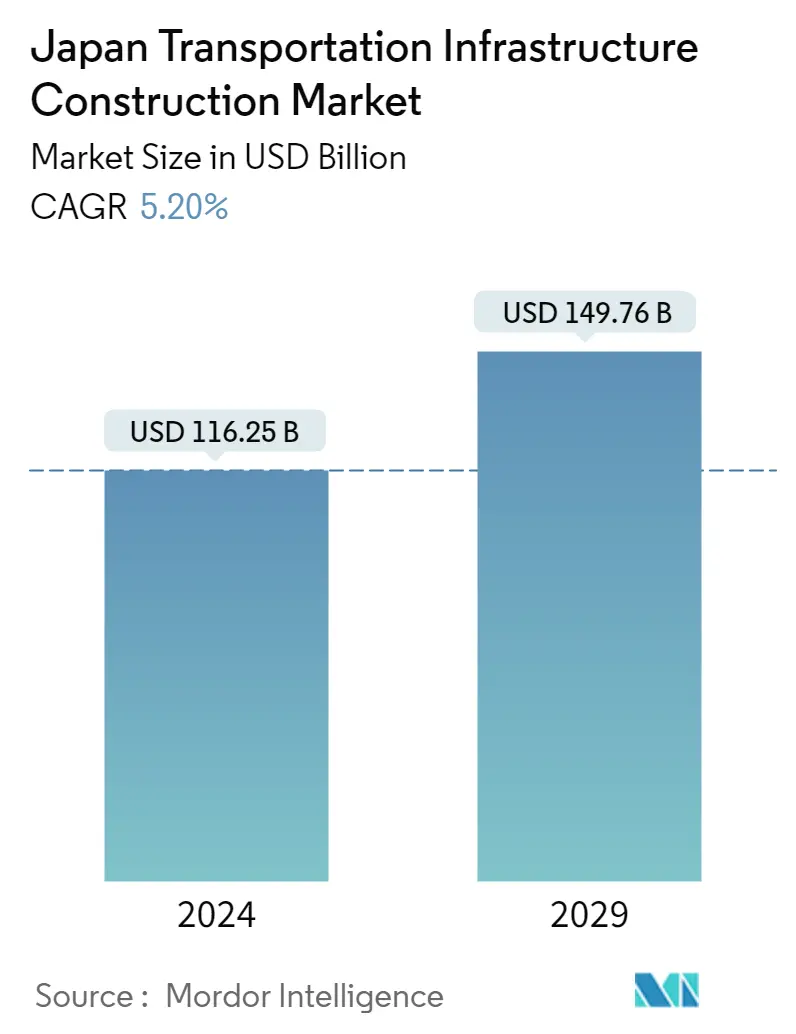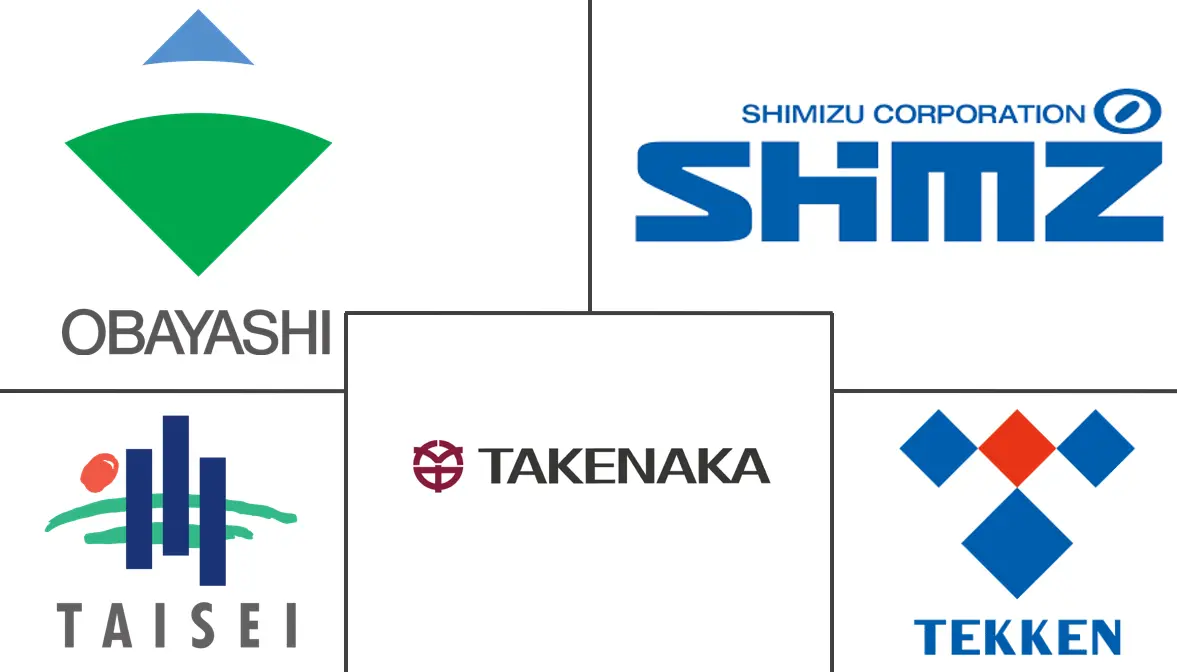Market Size of Japan Transportation Infrastructure Construction Industry

| Study Period | 2019 - 2029 |
| Base Year For Estimation | 2023 |
| Market Size (2024) | USD 116.25 Billion |
| Market Size (2029) | USD 149.76 Billion |
| CAGR (2024 - 2029) | 5.20 % |
| Market Concentration | Low |
Major Players
*Disclaimer: Major Players sorted in no particular order |
Japan Transportation Infrastructure Construction Market Analysis
The Japan Transportation Infrastructure Construction Market size is estimated at USD 116.25 billion in 2024, and is expected to reach USD 149.76 billion by 2029, growing at a CAGR of 5.20% during the forecast period (2024-2029).
The pandemic led the Japanese economy to contract by 29 percent on an annualized basis in the year 2020. In December 2020, real wages fell for the tenth consecutive month, reaching their worst level since 2014. Exports dropped 11.1 percent, their lowest since 2012. the central government produced stimulus packages that totaled roughly two-thirds of Japan’s economy. These covered direct funding to individuals along with initiatives such as digital infrastructure and carbon-reducing technology, both with an eye to the shape of Japan’s post-COVID economy, as well as financing and loan guarantees for small- and medium-sized enterprises impacted by the pandemic.
Japan’s roads are getting old, so much so that certain parts are dangerous. A survey by the Land, Infrastructure, Transport, and Tourism Ministry shows that 45,000 bridges and tunnels are waiting for repairs. The figure represents 60% of the structures cited nationwide for restoration. In the post-war years, Japan pressed ahead with infrastructure projects to support a growing population. Officials in Toyama Prefecture, on the Sea of Japan coast, are struggling with a budget shortfall for bridge maintenance.
Japan is not only committed to the development of hardware but also to human resources for sophisticated operation and maintenance of the infrastructure. The technological transfer is also conducted to support the local people in developing their infrastructure. As reported in May 2022, TOKYO: Japan, the United States, India, and Australia plan to invest at least USD 50 billion into infrastructure projects in the Asia-Pacific region over the next five years to assist projects in the Indo-Pacific region.
In Japan, which is prone to natural disasters, the construction sector is also of great importance for reconstruction and disaster prevention. As natural catastrophes such as floods have caused increasing damage in recent years, affecting annual budgets for reconstruction and disaster prevention, they will likely continue to create demand for infrastructure work.
As of March 2022, the Canadian Solar Infrastructure Fund was the leading infrastructure fund listed on the Tokyo Stock Exchange (TSE), with a market capitalization of 47.02 billion Japanese yen. The infrastructure fund market on the Tokyo Stock Exchange was established in 2015 and is based on the regulatory framework of the real estate investment trust (REIT) market. Infrastructure funds listed on the TSE invest primarily in renewable energy facilities, such as solar farms.
Japan Transportation Infrastructure Construction Industry Segmentation
The transportation infrastructure construction market includes a wide range of construction activities involving reforming existing constructions, building new infrastructures, and extending or demolishing projects.
A complete assessment of Japan's transportation infrastructure Construction Market includes an assessment of the economy market overview, market size estimation for key segments, and emerging trends in the market segments in the report. The report sheds light on the market trends like growth factors, restraints, and opportunities in this sector. The competitive landscape of the Japan Transportation Infrastructure Construction Market is depicted through the profiles of active key players. The report also covers the impact of COVID–19 on the market and future projections.
Japan's transportation infrastructure construction market is segmented by type (roadways, railways, ports & inland waterways, and airways).
The report offers market size and forecasts for the Japanese transportation infrastructure construction market in value (USD) for all the above segments.
| By Type | |
| Roadways | |
| Railways | |
| Airports | |
| Ports and Inland Waterways |
Japan Transportation Infrastructure Construction Market Size Summary
The Japan transportation infrastructure construction market is poised for significant growth over the forecast period, driven by a combination of government initiatives, technological advancements, and increasing demand for sustainable infrastructure. The market is characterized by a fragmented landscape with major local and international players such as Tekken Corporation, TOA CORPORATION, and Penta-Ocean Construction. The Japanese government has been proactive in addressing the challenges posed by aging infrastructure, with a substantial focus on repairing and upgrading roads, bridges, and tunnels. Additionally, the country's commitment to disaster prevention and reconstruction, particularly in the face of natural calamities, underscores the critical role of the construction sector in maintaining and enhancing transportation networks. The market is further bolstered by strategic investments in digital infrastructure and carbon-reducing technologies, aligning with Japan's post-COVID economic recovery plans.
The expansion of electric vehicle sales and the development of battery-charging infrastructure are also contributing to the growth of the transportation infrastructure construction market in Japan. Despite the relatively low market share of electric vehicles compared to regions like China and Europe, the increasing presence of foreign electric vehicle brands and government subsidies are expected to drive demand for supporting infrastructure. Moreover, successful infrastructure planning is seen as a key factor in boosting tourism, with ongoing efforts to enhance airport facilities and optimize transportation networks. The market's growth is supported by upcoming major projects and increased government investments, creating opportunities for new entrants and fostering competition among established players. Collaborative international ventures, such as those with Canada and the United States, further highlight Japan's strategic focus on regional infrastructure development, particularly in the Asia-Pacific region.
Japan Transportation Infrastructure Construction Market Size - Table of Contents
-
1. Market Insights and Dynamic
-
1.1 Market Overview
-
1.2 Market Dynamics
-
1.2.1 Drivers
-
1.2.1.1 Development of sustainable and energy-efficient transportation infrastructure
-
1.2.1.2 Growth in demand for new road and railway construction projects
-
-
1.2.2 Restraints
-
1.2.2.1 Funding is a major challenge for infrastructure construction and maintenance
-
-
1.2.3 Opportunities
-
1.2.3.1 Increase in infrastructure spending
-
-
-
1.3 Government Regulations and Initiatives
-
1.4 Supply Chain/Value Chain Analysis
-
1.5 Porter's Five Forces Analysis
-
1.5.1 Bargaining Power of Suppliers
-
1.5.2 Bargaining Power of Buyers/Consumers
-
1.5.3 Threat of New Entrants
-
1.5.4 Threat of Substitute Products
-
1.5.5 Intensity of Competitive Rivalry
-
-
1.6 Technology Snapshot and Digital Trends
-
1.7 Modernization of the Transportation Infrastructure Sector
-
1.8 Major Infrastructure Development Projects
-
1.9 Impact of COVID-19 on the Market
-
-
2. Market Segmentation
-
2.1 By Type
-
2.1.1 Roadways
-
2.1.2 Railways
-
2.1.3 Airports
-
2.1.4 Ports and Inland Waterways
-
-
Japan Transportation Infrastructure Construction Market Size FAQs
How big is the Japan Transportation Infrastructure Construction Market?
The Japan Transportation Infrastructure Construction Market size is expected to reach USD 116.25 billion in 2024 and grow at a CAGR of 5.20% to reach USD 149.76 billion by 2029.
What is the current Japan Transportation Infrastructure Construction Market size?
In 2024, the Japan Transportation Infrastructure Construction Market size is expected to reach USD 116.25 billion.

